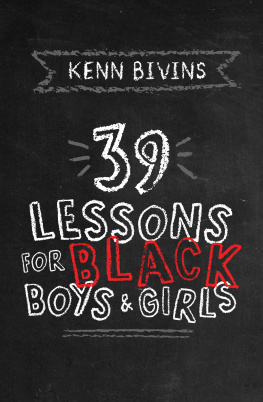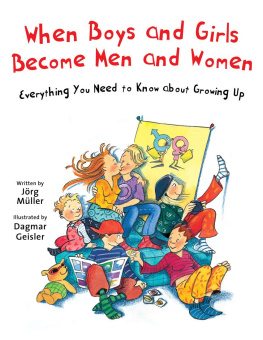Helping BOYS
Succeed in School
A PRACTICAL GUIDE FOR PARESNTS AND TEACHER
TERRY W. NEU, PH.D., & RICH WEINFELD

PRUFROCK PRESS INC.
WACO, TX
Copyright 2007 Prufrock Press Inc.
Edited by Lacy Elwood
Cover and Layout Design by Marjorie Parker
ISBN-13: 978-1-59363-525-1
ISBN-10: 1-59363-525-7
The Da Vincis Car activity in was compiled and developed by Bill Brown, Director, Eli Whitney Museum and Workshop, in conjunction with Terry W. Neu, Ph.D., Project Coordinator, Project HIGH HOPES, for Javits Act Program #R206R00001. The activity is adapted here with permission from its authors.
The activity, Whats the Difference? An Experiment in Herpetology, in was compiled and developed by Terry W. Neu, Ph. D., Project Coordinator, Project HIGH HOPES, for Javits Act Program #R206R00001. The activity is adapted here with permission from its author.
No part of this book may be reproduced, translated, stored in a retrieval system, or transmitted, in any form or by any means, electronic, mechanical, photocopying, microfilming, recording, or otherwise, without written permission from the publisher.
Printed in the United States of America.
At the time of this books publication, all facts and figures cited are the most current available. All telephone numbers, addresses, and Web site URLs are accurate and active. All publications, organizations, Web sites, and other resources exist as described in the book, and all have been verified. The authors and Prufrock Press Inc. make no warranty or guarantee concerning the information and materials given out by organizations or content found at Web sites, and we are not responsible for any changes that occur after this books publication. If you find an error, please contact Prufrock Press Inc.

Prufrock Press Inc.
P.O. Box 8813
Waco, TX 76714-8813
Phone: (800) 998-2208
Fax: (800) 240-0333
http://www.prufrock.com
To our sons, Jake, Nic, and Jake, as well as the many other boys in whom we have personally seen the potential to do great things.
Acknowledgements
We would like to thank Kenneth Caputo for his contributions to the bullying information in . More about Ken can be found in the About the Contributor section of this book.
Introduction
Over the past 6 years, we have been combining our skills to bring information and stories about the boys weve worked with to audiences at conferences and workshops across the United States. We are dedicated to helping boys succeed in school and life. As educators who have worked extensively with the gifts and the special needs of boys, and, often, the combination of both within the same boy, we have years of experience to share. As the fathers of boys, we have the understanding of the hopes and fears that parents have concerning their sons success.
You may notice that this book encompasses several voices: Terrys, Richs, and those of the boys weve worked with over the years. Our partnership as coauthors reflects our personalities: Rich is the facts guy, and Terry is the storyteller. In parts of this book you may hear more of Richs voice, as you hear about the statistics, describing the problems and providing the data that support our solutions. In other parts of this book, you will hear more of Terrys voice as he tells the tales of the boys we have worked with. In some parts, you may hear the boys themselves, as we put the stories theyve shared with us to paper. Although these stories may be composites of several boys, they are based on actual boys we have worked with over the years. We hope that from all these voices, you will gain an understanding of both the facts and the emotions that are involved in ensuring boys success. Most importantly, we believe you will be given practical tools that you, as parents and educators, can immediately use to help your boys. We hope that our words, and those of the boys weve worked with, can help make a difference in the lives of other boys, both those who struggle, and those who need a simple nudge toward the path of success.
chapter 1
Whats Going on With the Boys?
I t was standing room only for the presentation on boys issues in education at a national conference on education. We were there as concerned educators who had noticed the overrepresentation of boys in the special education programs that we had worked in and administered over the years. We were also there as the fathers of boys who were already expressing a dislike for the reading and writing that they were required to do in school. Along with the rest of the crowd, we nodded our agreement as the presenter talked about the problems facing boys in our schools. We waited in anticipation for the speaker to offer solutions to these problems. Our enthusiasm soon turned to disappointment, for nearly all of the solutions offered by the speaker had one common theme: Our boys would be OK if we could just teach them to be more like girlsmore sensitive, more cooperative, and more able to understand and verbalize their emotions and those of others.
While this theme seemed to find approval with many in the audience, we left the presentation feeling that a major point had been missed. We saw the truth in the value of helping boys become more sensitive and in touch with their emotions so that they could be more cooperative members of their class and better able to relate to the emotions presented in their reading and writing assignments. On the other hand, we left feeling that the presentation missed the important issue of how, rather than changing the boys to fit our schools, schools might change to capitalize and expand on the strengths of boys. We had seen firsthand the ways boys were suffering and failing in our schools. We had also seen how these same boys could thrive when provided with alternative ways to learn. We left the session determined to do our part to find and share solutions that would capitalize on the strengths, talents, and interests that we had seen over the years in the boys with whom we had worked.
The first step toward making changes in how we educate boys is to have a common understanding of the problems that boys currently face and an understanding of the possible causes of those problems. By now, most of us have heard that boys are not doing as well as girls inside or outside of our schools. First Lady Laura Bush has chosen to make this issue one of her priorities for her second term in the White House. Mrs. Bush and others are voicing concern about some startling and troubling statistics.
HOW ARE BOYS PERFORMING IN SCHOOL?
Nationally, boys are scoring lower in reading and in writing than girls, and their lead over girls in areas like science and math has now virtually disappeared. Results from the 2002 National Assessment of Educational Progress (NAEP) show that in the area of writing boys are 17 percentage points behind girls in the 4th grade, 21 percentage points behind in 8th grade, and a whopping 25 percentage points behind in 12th grade (U.S. Department of Education, 2003). This gap between the genders in writing has increased over the years. The 2002 NAEP reading results also showed a gap between boys and girls at the two tested levels, fourth and eighth grade. In reading, girls outperformed boys by 7 percentage points in fourth grade and 9 percentage points in eighth grade. While in school, boys are less likely to earn good grades, take challenging courses, and be active in school. Besides trailing in academic performance, boys are more likely to drop out of high school than girls and less likely than their female counterparts to graduate high school, to attend college, and to go on for graduate degrees (Mortenson, 2005) The college admission trend is likely to be exacerbated by the new SAT test, which is predicted to favor girls over boys (Cloud, 2003). As Lesley Stahl (2003) reported, somewhat tongue-in-cheek, on a









